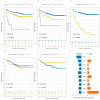Prognostic Factors Analysis of Metastatic Recurrence in Cervical Carcinoma Patients Treated with Definitive Radiotherapy: A Retrospective Study Using Mixture Cure Model
- PMID: 37296875
- PMCID: PMC10252127
- DOI: 10.3390/cancers15112913
Prognostic Factors Analysis of Metastatic Recurrence in Cervical Carcinoma Patients Treated with Definitive Radiotherapy: A Retrospective Study Using Mixture Cure Model
Abstract
Objectives: This study aims to identify prognostic factors associated with metastatic recurrence-free survival of cervical carcinoma (CC) patients treated with radical radiotherapy and assess the cure probability of radical radiotherapy from metastatic recurrence.
Methods: Data were from 446 cervical carcinoma patients with radical radiotherapy for an average follow up of 3.96 years. We applied a mixture cure model to investigate the association between metastatic recurrence and prognostic factors and the association between noncure probability and factors, respectively. A nonparametric test of cure probability under the framework of a mixture cure model was used to examine the significance of cure probability of the definitive radiotherapy treatment. Propensity-score-matched (PSM) pairs were generated to reduce bias in subgroup analysis.
Results: Patients in advanced stages (p = 0.005) and those with worse treatment responses in the 3rd month (p = 0.004) had higher metastatic recurrence rates. Nonparametric tests of the cure probability showed that 3-year cure probability from metastatic recurrence was significantly larger than 0, and 5-year cure probability was significantly larger than 0.7 but no larger than 0.8. The empirical cure probability by mixture cure model was 79.2% (95% CI: 78.6-79.9%) for the entire study population, and the overall median metastatic recurrence time for uncured patients (patients susceptible to metastatic recurrence) was 1.60 (95% CI: 1.51-1.69) years. Locally advanced/advanced stage was a risk factor but non-significant against the cure probability (OR = 1.078, p = 0.088). The interaction of age and activity of radioactive source were statistically significant in the incidence model (OR = 0.839, p = 0.025). In subgroup analysis, compared with high activity of radioactive source (HARS), low activity of radioactive source (LARS) significantly contributed to a 16.1% higher cure probability for patients greater than 53 years old, while cure probability was 12.2% lower for the younger patients.
Conclusions: There was statistically significant evidence in the data showing the existence of a large amount of patients cured by the definitive radiotherapy treatment. HARS is a protective factor against metastatic recurrence for uncured patients, and young patients tend to benefit more than the elderly from the HARS treatment.
Keywords: activity of radioactive source; brachytherapy; cervical carcinoma; metastatic recurrence; mixture cure model.
Conflict of interest statement
The authors declare no conflict of interest.
Figures




Similar articles
-
Impact of radiation source activity on short- and long-term outcomes of cervical carcinoma patients treated with high-dose-rate brachytherapy: A retrospective cohort study.Gynecol Oncol. 2020 Nov;159(2):365-372. doi: 10.1016/j.ygyno.2020.08.037. Epub 2020 Sep 13. Gynecol Oncol. 2020. PMID: 32933759
-
Which Factors Are Associated with Local Control and Survival of Patients with Localized Pelvic Ewing's Sarcoma? A Retrospective Analysis of Data from the Euro-EWING99 Trial.Clin Orthop Relat Res. 2020 Feb;478(2):290-302. doi: 10.1097/CORR.0000000000000962. Clin Orthop Relat Res. 2020. PMID: 31580267 Free PMC article.
-
Efficacy of high-dose-rate brachytherapy with different radiation source activities among cervical cancer patients and risk factors for long-term outcomes: A 6-year retrospective study.Brachytherapy. 2024 Jan-Feb;23(1):35-44. doi: 10.1016/j.brachy.2023.09.010. Epub 2023 Oct 31. Brachytherapy. 2024. PMID: 37919124
-
Extended-field radiotherapy for locally advanced cervical cancer.Cochrane Database Syst Rev. 2018 Oct 26;10(10):CD012301. doi: 10.1002/14651858.CD012301.pub2. Cochrane Database Syst Rev. 2018. PMID: 30362204 Free PMC article.
-
Overview of resistance to systemic therapy in patients with breast cancer.Adv Exp Med Biol. 2007;608:1-22. doi: 10.1007/978-0-387-74039-3_1. Adv Exp Med Biol. 2007. PMID: 17993229 Review.
References
-
- Petereit D.G., Sarkaria J.N., Potter D.M., Schink J.C. High-Dose-Rate versus Low-Dose-Rate Brachytherapy in the Treatment of Cervical Cancer: Analysis of Tumor Recurrence—The University of Wisconsin Experience. Int. J. Radiat. Oncol. Biol. Phys. 1999;45:1267–1274. doi: 10.1016/S0360-3016(99)00262-X. - DOI - PubMed
Grants and funding
LinkOut - more resources
Full Text Sources
Miscellaneous

